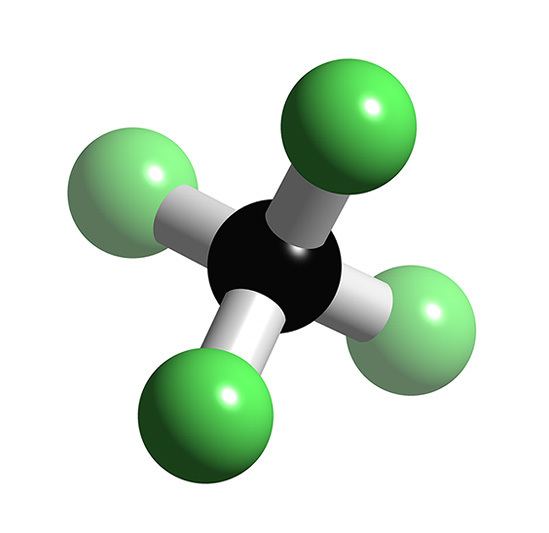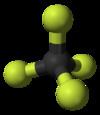Formula CF4 Molar mass 88.0043 g/mol Density 3.72 kg/m³ Pubchem 6393 | Boiling point -127.8 °C Melting point -183.6 °C Appearance Colorless gas | |
 | ||
Related fluoromethanes Related compounds | ||
What does tetrafluoromethane mean
Tetrafluoromethane, also known as carbon tetrafluoride, is the simplest fluorocarbon (CF4). It has a very high bond strength due to the nature of the carbon–fluorine bond. It can also be classified as a haloalkane or halomethane. Because of the multiple carbon–fluorine bonds, and the high electronegativity of fluorine, the carbon in tetrafluoromethane has a significant positive partial charge which strengthens and shortens the four carbon–fluorine bonds by providing additional ionic character. Tetrafluoromethane is a potent greenhouse gas.
Contents
- What does tetrafluoromethane mean
- Tetrafluoromethane dynamic viscosity and temperature
- Bonding
- Preparation
- Laboratory synthesis
- Reactions
- Uses
- Environmental effects
- Health risks
- References

Tetrafluoromethane dynamic viscosity and temperature
Bonding

Carbon–fluorine bonds are the strongest single bonds in organic chemistry. Additionally, they strengthen as more carbon–fluorine bonds are added to the same carbon. In the one carbon organofluorine compounds represented by molecules of fluoromethane, difluoromethane, trifluoromethane, and tetrafluoromethane, the carbon–fluorine bonds are strongest in tetrafluoromethane. This effect is due to the increased coulombic attractions between the fluorine atoms and the carbon because the carbon has a positive partial charge of 0.76.
Preparation

Tetrafluoromethane is the product when any carbon compound, including carbon itself, is burned in an atmosphere of fluorine. With hydrocarbons, hydrogen fluoride is a coproduct. It was first reported in 1926. It can also be prepared by the fluorination of carbon dioxide, carbon monoxide or phosgene with sulfur tetrafluoride. Commercially it is manufactured by the reaction of hydrogen fluoride with dichlorodifluoromethane or chlorotrifluoromethane; it is also produced during the electrolysis of metal fluorides MF, MF2 using a carbon electrode.

Although it can be made from myriad precursors and fluorine, elemental fluorine is expensive and difficult to handle. Consequently, CF
4 is prepared on an industrial scale using hydrogen fluoride:
Laboratory synthesis
Tetrafluoromethane can be prepared in the laboratory by the reaction of silicon carbide with fluorine.
SiC + 4 F2 → CF4 + SiF4Reactions

Tetrafluoromethane, like other fluorocarbons, is very stable due to the strength of its carbon–fluorine bonds. The bonds in tetrafluoromethane have a bonding energy of 515 kJ⋅mol−1. As a result, it is inert to acids and hydroxides. However, it reacts explosively with alkali metals. Thermal decomposition or combustion of CF4 produces toxic gases (carbonyl fluoride and carbon monoxide) and in the presence of water will also yield hydrogen fluoride.
It is very slightly soluble in water (about 20 mg⋅L−1), but miscible with organic solvents.
Uses

Tetrafluoromethane is sometimes used as a low temperature refrigerant. It is used in electronics microfabrication alone or in combination with oxygen as a plasma etchant for silicon, silicon dioxide, and silicon nitride. It also has uses in neutron detectors
Environmental effects
Tetrafluoromethane is a potent greenhouse gas that contributes to the greenhouse effect. It is very stable, has an atmospheric lifetime of 50,000 years, and a high greenhouse warming potential of 6500 (which is given for the first 100 years thereof, CO2 has a factor of 1); however, the low amount in the atmosphere restricts the overall radiative forcing effect.
Although structurally similar to chlorofluorocarbons (CFCs), tetrafluoromethane does not deplete the ozone layer. This is because the depletion is caused by the chlorine atoms in CFCs, which dissociate when struck by UV radiation. Carbon–fluorine bonds are stronger and less likely to dissociate. According to Guinness World Records Tetrafluoromethane is the most persistent greenhouse gas.
Main industrial emissions of tetrafluoromethane besides hexafluoroethane are produced during production of aluminium using Hall-Héroult process. CF4 also is produced as product of the breakdown of more complex compounds such as halocarbons.
Health risks
Due to its density, tetrafluoromethane can displace air, creating an asphyxiation hazard in inadequately ventilated areas.
